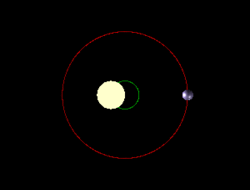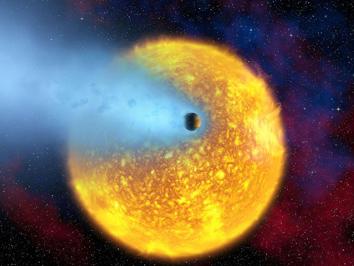Astronomers have found that a planet discovered earlier this year is, in many ways, Earth’s twin. It’s the smallest exoplanets yet found for which we’ve been able to measure both its size and density. The only problem (apropos for Halloween): It’s a burned-out corpse of a world. And we don’t know how it got that way*.
Here’s the deal. First, I wrote about the discovery of the planet, called Kepler-78b, when it was announced in August, and you can get the background details there. But basically, it was found using the transit method. Its orbit around its parent star is seen almost exactly edge-on from Earth, so once every orbit it gets directly in between us and the star. When it does that, it blocks a wee bit of the star’s light, and we see a corresponding dip in that starlight which repeats every time the planet orbits the star.
In the case of Kepler-78b, it circles its sun in just 8.5 hours. That’s fast! That means the planet’s orbit is incredibly close to the star, screaming around it just 900,000 kilometers (550,000 miles) or so above its surface! The surface temperature of the planet must be close to 2400° Celsius (4300° F).
The size of the planet can also be found by how much starlight it blocks; the bigger the planet, the more light gets blocked. Observing multiple transits, astronomers found that Kepler-78b is very nearly the size of Earth: It’s only about 1.2 times bigger than our home world.
Now mind you, all this was known when the planet’s discovery was announced a few months ago. However, there’s a new and very important piece of info that’s critical in understanding it: It has a density very similar to Earth’s as well, meaning it must be a rocky-iron world like ours!
The density of an object is defined by how much mass is squeezed into its volume. So iron, for example, is much more dense than water (about eight times as dense); a glass of water might have a mass of half a kilo (about a pound), but if it were filled with iron it would mass about 4 kilos (9 pounds). Rock, as another example, is only about two or three times denser than water. This means that if you can measure the density of an object, you can make a pretty good guess as to its composition as well.

Illustration by NASA / Spaceplace
To get the density of an object, you need its size and its mass. We have Kepler-78b’s size form the transit observations, so now we need the mass. But that can be found too! The gravity of an object depends on its mass, and the gravity of the planet can affect the star. As a planet orbits its star it makes a big circle. But the planet’s gravity pulls on the star, too, so the star makes a little circle as well. It’s like two kids facing each other and holding hands. If they spin around, the lighter child will make a big circle, and the heavier one will only make a little circle.
As the star goes around its little circle, it sometimes moves toward us, and sometimes away. That means there’s a Doppler shift in its light, and that can be measured. The amount depends on the gravity of the planet, which depends on the mass. Boom! Measuring that shift in light from the star gives you the planet’s mass.
Kepler-78b, it turns out, has a mass of 1.7 times that of the Earth. That may sound like a lot, but remember, Kepler-78b is bigger, too. When you do the math, you find that its density is almost exactly the same as Earth’s!
This means Kepler-78b is most likely made of roughly the same stuff as Earth, and in roughly the same proportion. It may very well have a dense iron core and a lighter rocky mantle just as Earth does.
That’s amazing.
However, the resemblance ends there. With a daytime temperature in the thousands of degrees, the surface of the planet is almost certainly molten rock, so it’s not exactly a vacation spot. But it does show that the Earth is not a one-off planet; the Universe is quite capable of making Earth-sized planets that have the same physical characteristics as well.
…which brings us to another problem, though. Just how did Kepler-78b get so freaking close to its star?
Everything we understand about the way planets form tells us that it could not have been born in its present location. Planets coalesce out of a disk of dust, rock, and ice that swirls around a star when it’s very young. However, the gravity of the star itself should prevent a planet from forming that close in, tearing apart the material before it can accumulate (the intense heat near the star doesn’t help much either). However, we do know that planets can form farther out and then migrate inwards, toward the star, over time. Basically, the planet interacts with the thick dust of junk around it, which robs the planet of orbital energy, sending it inward to the star. Near the star the disk peters out, and the migration stops.
This method works very effectively for big planets like Jupiter, but less well for smaller ones like Kepler-78b. It generally also doesn’t get the planet quite as close to its star as Kepler-78b is, either. So we’re still left with a bit of a mystery.

Drawing by NASA, European Space Agency, Alfred Vidal-Madjar (Institut d’Astrophysique de Paris, CNRS)
I wonder, though. It’s possible that Kepler-78b wasn’t always the way it is now. I’m speculating, but one possible answer is that when it first formed, Kepler-78b was more massive and had a thick atmosphere. It could’ve migrated inward, then lost its air as it got close to the star and heated up; its own gravity couldn’t hold on to its atmosphere as the star superheated it. What’s left now is the core of that once-bigger planet, which coincidentally is about the same size, density, and mass as Earth.
Again, this is just a guess. We really don’t know how Kepler-78b found itself in the spot it’s in. But, as I said above, this is the smallest exoplanet found for which we’ve determined both its size and its mass. As we keep looking, we’ll find more, and as we do we’ll be able to catalog them, look for trends. Will they all be molten star-huggers like Kepler-78b, or will more be farther from their stars? Is Kepler-78b more massive and denser than most, or less? And what about other planets orbiting these stars? Could they play into this as well?
As usual, getting a new answer only opens up a box full of more questions. Science is pretty good about this. But that’s one of the main reasons this is so much fun! Once you nail something down, really understand it, you find that there are a pile of other things going on you didn’t even know about.
One of my favorite things about science is that it’s like an infinite jigsaw puzzle. There’s always another piece, always more of the picture to see. The fun, literally, never ends.
* I’ll assume Rodney McKay had nothing to do with it.
[Correction (Oct. 30, 2013 at 8:40 UTC): In the original post, I inadvertently wrote that the orbital period of the planet was 8.5 days, not hours.]
